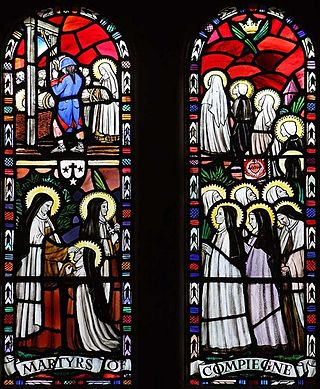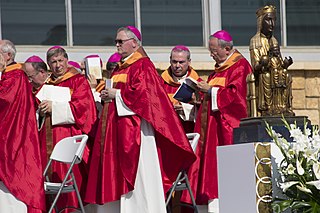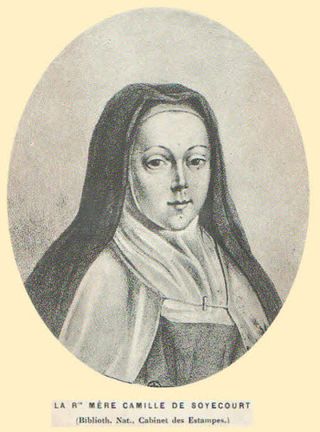
Many religious communities have the term Sisters of Charity in their name. Some Sisters of Charity communities refer to the Vincentian tradition alone, or in America to the tradition of Saint Elizabeth Ann Seton, but others are unrelated. The rule of Vincent de Paul for the Daughters of Charity has been adopted and adapted by at least sixty founders of religious institutes for sisters around the world.

The Company of the Daughters of Charity of Saint Vincent de Paul, commonly called the Daughters of Charity or Sisters of Charity of Saint Vincent De Paul, is a Society of Apostolic Life for women within the Catholic Church. Its members make annual vows throughout their life, which leaves them always free to leave, without the need of ecclesiastical permission. They were founded in 1633 by Vincent de Paul and state that they are devoted to serving the poor through the corporal and spiritual works of mercy.
The Daughters of the Cross of Liège are religious sisters in the Catholic Church who are members of a religious congregation founded in 1833 by Marie Thérèse Haze (1782–1876). The organization's original mission is focused on caring for the needs of their society through education and nursing care.

The English Benedictine Congregation (EBC) is a congregation of autonomous abbatial and prioral monastic communities of Catholic Benedictine monks, nuns, and lay oblates. It is technically the oldest of the nineteen congregations affiliated to the Benedictine Confederation.

The Archdiocese of Cambrai is a Latin Church ecclesiastical jurisdiction or archdiocese of the Catholic Church in France, comprising the arrondissements of Avesnes-sur-Helpe, Cambrai, Douai, and Valenciennes within the département of Nord, in the region of Nord-Pas-de-Calais. The current archbishop is Vincent Dollmann, appointed in August 2018. Since 2008 the archdiocese has been a suffragan of the Archdiocese of Lille.

Louise de Marillac , also known as Louise Le Gras, was the co-founder, with Vincent de Paul, of the Daughters of Charity. She is venerated as a saint by the Catholic Church and the Episcopal Church in the United States of America.

The Sisters of Charity of Saint Vincent de Paul were founded on May 11, 1849, when the four founding Sisters of Charity arrived in Halifax, Nova Scotia, from New York City; this has been designated a National Historic Event.

The Martyrs of Compiègne were the 16 members of the Carmel of Compiègne, France: 11 Discalced Carmelite nuns, three lay sisters, and two externs. They were executed by the guillotine towards the end of the Reign of Terror, at what is now the Place de la Nation in Paris on 17 July 1794, and are venerated as beatified martyrs of the Catholic Church. Ten days after their execution, Maximilien Robespierre himself was executed, ending the Reign of Terror. Their story has inspired a novella, a motion picture, a television movie, and an opera, Dialogues of the Carmelites, written by French composer Francis Poulenc.
The Sisters of the Blessed Sacrament and Our Lady is an enclosed religious order and a reform of the Dominican Order devoted to the perpetual adoration of the Blessed Sacrament. The congregation was founded in Marseille in 1659 by a Dominican priest, Anthony Le Quieu.
The Religious Congregations of the Syro-Malabar Catholic Church are divided in Code of Canons of the Oriental Churches as Monasteries, Hermitages, Orders, Congregations, Societies of Common Life in the Manner of Religious, Secular Institutes and Societies of Apostolic Life.

The Tyburn Nuns, formally, Adorers of the Sacred Heart of Jesus of Montmartre, is a Catholic congregation of Benedictine nuns. The congregation was originally founded in Paris but was obliged to find a new Mother House due to French legislation passed in 1901. Two years later it relocated to London and subsequently established additional convents in nine other countries. The nuns at the London convent practice the Perpetual Adoration of the Blessed Sacrament and maintain a shrine dedicated to the Catholic martyrs of the English Reformation.
Catholic sisters and nuns in Canada have been an important presence since the 17th century.

The 522 Spanish Martyrs were victims of the Spanish Civil War beatified by the Roman Catholic Church on 13 October 2013 by order of Pope Francis. It was one of the largest number of persons ever beatified in a single ceremony in the Church's 2000-year history. They originated from all parts of Spain. Their ages ranged from 18 to 86 years old.

Louis Martin and Azélie-Marie ("Zélie") Guérin Martin were a French Roman Catholic couple and the parents of five nuns, including Thérèse of Lisieux, a Carmelite nun who was canonized as a saint of the Catholic Church in 1925 and Léonie Martin declared "Servant of God" in 2015. In 2015, the couple were also canonized as saints, becoming the first spouses in the church's history to be canonized as a couple.

Camille de Soyécourt (1757–1849) or Thérèse Camille de l'Enfant-Jésus was a French Discalced Carmelite nun who restored the order in France after the French Revolution.

Catholic religious institutions, associations, and communities in Macau operate in the territory of the Macau Special Administrative Region (MSAR), which is currently under the ecclesiastical jurisdiction of the Diocese of Macau, founded on 23 January 1576. Besides its diocesan priests, this Catholic diocese is assisted by various male and female religious orders, congregations, and institutes. The diocese is also supported by various institutions, movements, brotherhoods, and associations of Catholic inspiration made up of lay and religious people. All these Catholic bodies provide a variety of religious, social, educational, welfare, and cultural services to the Catholic and non-Catholic populations of Macau.











